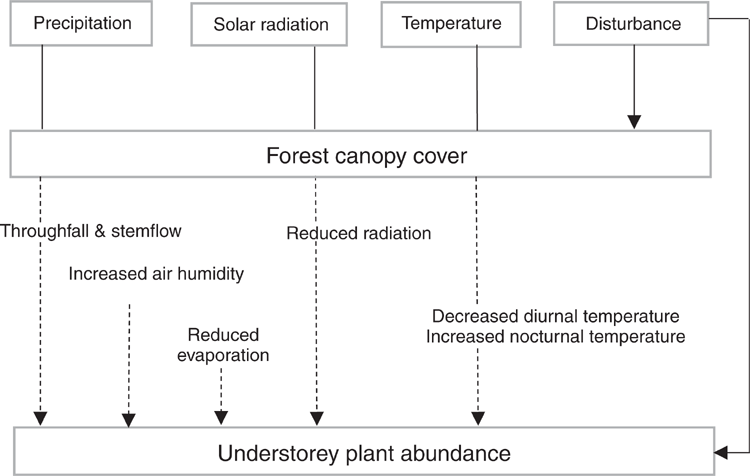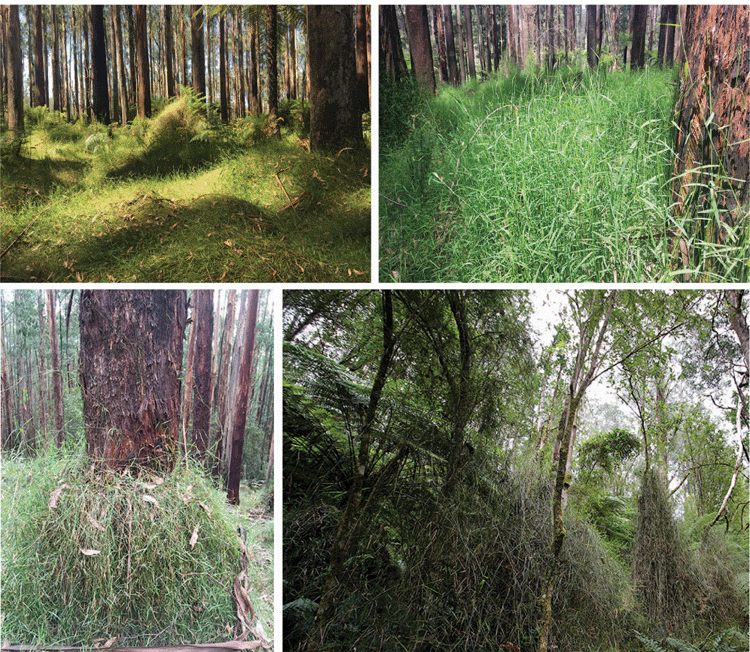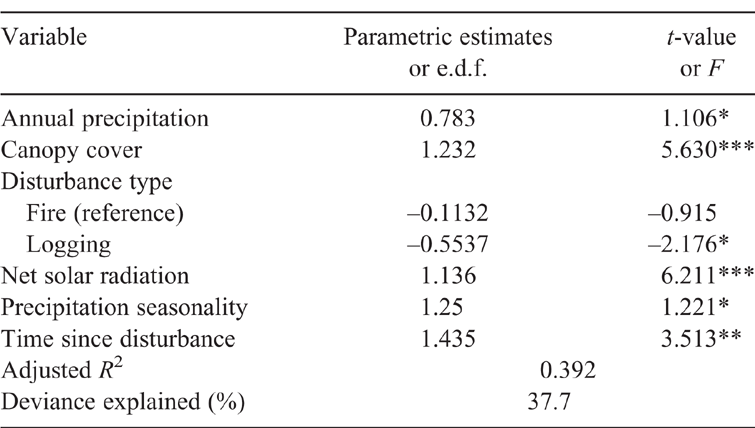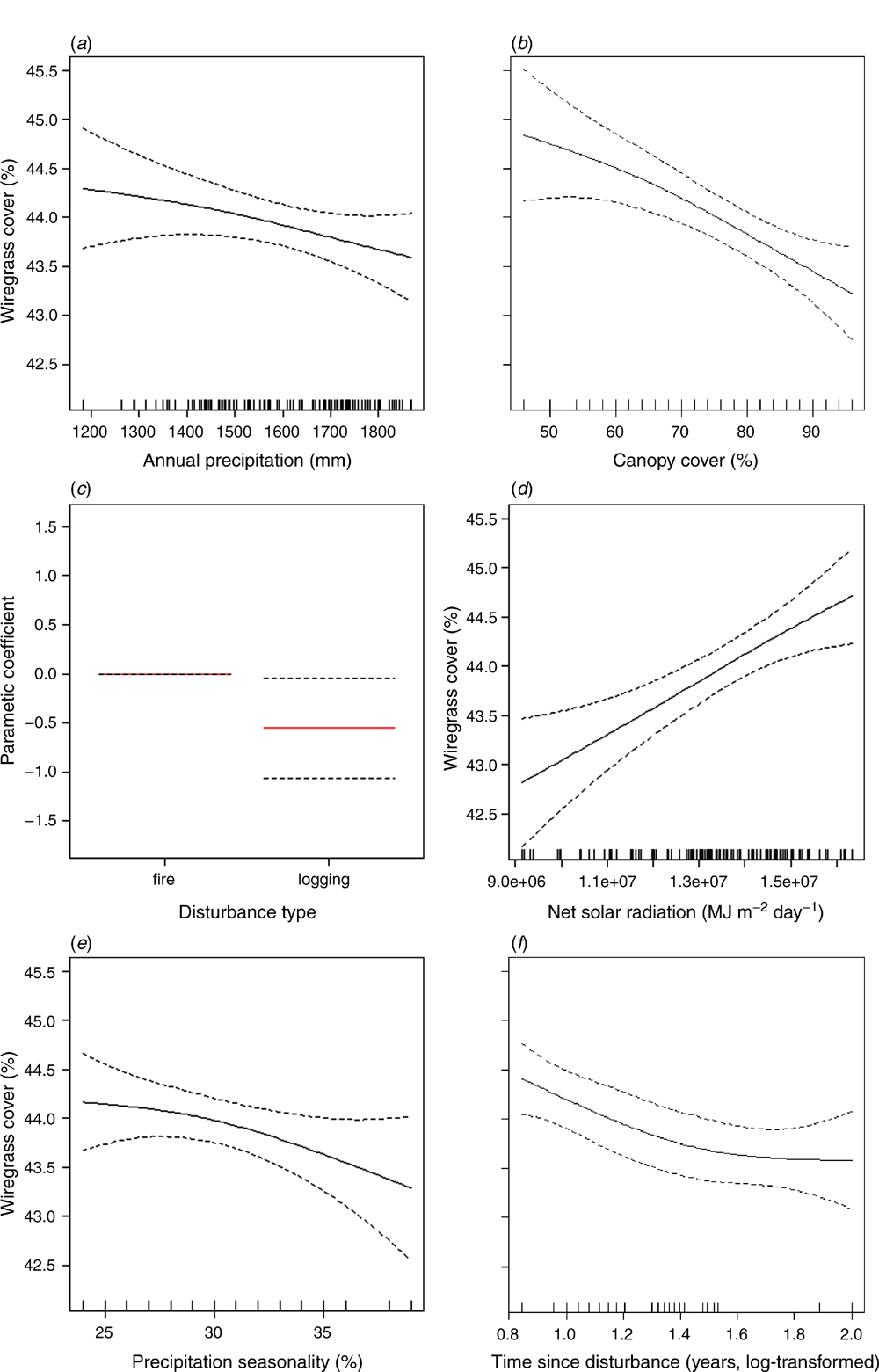Environmental factors associated with the abundance of forest wiregrass (Tetrarrhena juncea), a flammable understorey grass in productive forests
Geofe O. Cadiz A B D , Jane G. Cawson A , Trent D. Penman C , Alan York C and Thomas J. Duff A
A B D , Jane G. Cawson A , Trent D. Penman C , Alan York C and Thomas J. Duff A
A School of Ecosystem and Forest Sciences, University of Melbourne, Burnley Campus, 500 Yarra Boulevard, Richmond, Vic. 3121, Australia.
B Department of Biology and Environmental Science, College of Science, University of the Philippines Cebu, Gorordo Avenue, Lahug, Cebu City, 6000, Philippines.
C School of Ecosystem and Forest Sciences, University of Melbourne, Creswick Campus, Water Street, Creswick, Vic. 3363, Australia.
D Corresponding author. Email: gocadiz@up.edu.ph
Australian Journal of Botany 68(1) 37-48 https://doi.org/10.1071/BT19112
Submitted: 21 June 2019 Accepted: 17 March 2020 Published: 7 May 2020
Abstract
When flammable plant species become dominant they can influence the flammability of the entire vegetation community. Therefore, it is important to understand the environmental factors affecting the abundance of such species. These factors can include disturbances such as fire, which can promote the dominance of flammable grasses causing a positive feedback of flammability (grass–fire cycle). We examined the potential factors influencing the abundance of a flammable grass found in the understoreys of forests in south-east Australia, the forest wiregrass (Tetrarrhena juncea R.Br.). When wiregrass is abundant, its structural characteristics can increase the risk of wildfire ignition and causes fire to burn more intensely. We measured the cover of wiregrass in 126 sites in mountain ash forests in Victoria, Australia. Generalised additive models were developed to predict cover using climatic and site factors. The best models were selected using an information theoretic approach. The statistically significant factors associated with wiregrass cover were annual precipitation, canopy cover, disturbance type, net solar radiation, precipitation seasonality and time since disturbance. Canopy cover and net solar radiation were the top contributors in explaining wiregrass cover variability. Wiregrass cover was predicted to be high in recently disturbed areas where canopy cover was sparse, light levels high and precipitation low. Our findings suggest that in areas with wiregrass, disturbances such as fire that reduce canopy cover can promote wiregrass dominance, which may, in turn, increase forest flammability.
Additional keywords: canopy cover, disturbance, fire regime, grass–fire cycle, mountain ash.
Introduction
The influence of species on the emergent properties of an ecosystem is often proportional to their abundance (Parker et al. 1999). In fire-prone landscapes, such as in Australia, species within vegetation communities are fuels for wildfires (Murphy et al. 2013; Duff et al. 2017), and the traits of each species combine to influence flammability at landscape scales (Schwilk 2003; Schwilk and Caprio 2011; Zylstra et al. 2016; Tumino et al. 2019). When a flammable species becomes abundant it can increase the flammability of an entire vegetation community (Gill and Zylstra 2005; Schwilk and Caprio 2011; Zylstra 2011) by contributing a disproportionate amount to the total fuel load or by altering structural characteristics of the vegetation community, for example, increasing fuel continuity (Brooks et al. 2004; Berry et al. 2011). However, an increase in the abundance of a flammable species may not correlate with an increase in the flammability of a vegetation community if the fuel becomes more densely packed with a higher packing ratio or bulk density (van Wilgen and Richardson 1985; Scarff and Westoby 2006; Schwilk 2015; Fraser et al. 2016).
An example of an individual species that has become dominant and altered the flammability of a vegetation community is Lantana camara L. in the dry rainforest of north-eastern Australia. This species increases the continuity of fuel in the understorey, consequently increasing the potential intensity and extent of fires that occur (Berry et al. 2011). Similarly, the dominance of the invasive African gamba grass (Andropogon gayanus Kunth) in northern Australia savanna causes higher intensity fires by increasing the fuel load 7-fold in comparison to natural fuels (Rossiter et al. 2003; Setterfield et al. 2010). In some instances, a positive feedback can be created where fire promotes the abundance of a flammable grass species, which, in turn, facilitates further fires (D’Antonio and Vitousek 1992; Rossiter et al. 2003). This process, known as a grass–fire cycle, has been observed in different ecosystems around the world (D’Antonio and Vitousek 1992). A contrasting example is the succulent Carpobrotus edulis (L.) N.E. Br. in California (Zedler and Scheid 1988; D’Antonio et al. 1993), which has a high water content and low flammability, hence, reduces the flammability of the vegetation community when abundant (Brooks et al. 2004).
To better understand the drivers of flammability, it is important to understand the factors influencing the abundance of species that can have an effect on the flammability of plant communities. Many environmental factors are potentially important determinants of plant abundance, including precipitation, temperature, solar radiation, canopy cover and disturbance (Fig. 1). For example, studies have shown that in drier areas, drought-intolerant species are rare whereas drought-tolerant ones are generally abundant (Gaff and Latz 1978; Badano et al. 2005). Similarly, in warmer areas, cold-adapted plants are rare whereas thermophilic species are generally abundant (Vesperinas et al. 2001; Kullman 2008). Shade-tolerant species are also reported to dominate under deep shade where shade-intolerant ones are generally absent (Chávez and Macdonald 2010).
In multi-strata forest systems, canopy cover plays a role in regulating plant abundance by modifying the factors that directly drive plant abundance (Fig. 1). For example, light and water (from precipitation) are intercepted by the canopy (Valladares et al. 2016), resulting in a decrease in the availability of these resources. Canopy shading also decreases diurnal temperature and increases nocturnal temperature (Jacobs et al. 1994; Niinemets and Valladares 2004), resulting in narrower daily temperature fluctuations than those in the open. Studies also have shown that air humidity is increased, and evaporation is decreased under the canopy (Chen et al. 1995; Holmgren et al. 1997). Canopy cover can change in response to other factors including forest disturbance (e.g. fire, logging), drought or disease. Disturbances by themselves can also directly affect plant composition and abundance through their effects on mortality of plant populations or as a cue for regeneration and germination (e.g. fire-induced seed germination) (Gill 1981). The role of past disturbance influencing species abundance directly and indirectly is also emphasised by the grass–fire cycle concept (D’Antonio and Vitousek 1992).
One understorey species in south-eastern Australia that reportedly increases in abundance after a fire disturbance is the forest wiregrass (Tetrarrhena juncea R.Br., hereafter referred to as wiregrass) (Stuwe and Mueck 1990; Penman et al. 2009). Wiregrass has been reported to have a strong influence on the overall flammability of the coastal and foothill forests in south-eastern Australia (Buckley 1993; Fogarty 1993) by increasing the continuity of the fuel bed when it is abundant. It can sustain fire within a vegetation community even at high levels of humidity and at much higher surface litter moisture contents than fire would otherwise be sustained (Buckley 1993). Presumably this is because wiregrass has an aerated and elevated structure with a high fraction of suspended dead material (Fogarty 1993), which has a lower moisture content than the fuel on the forest floor as suspended materials have a high degree of exposure to atmospheric drying. Wiregrass is a scrambling grass that can climb over rigid supports even up to 6 m high, and as such, it is likely to become a ladder fuel, increasing the vertical and horizontal continuity of the fuel bed. Wiregrass is observed to abound under canopy gaps, with higher light levels thought to be the responsible factor stimulating thick growth in gaps (Lamp et al. 2001). However, Ashwell (1985), in his study on wiregrass ecology in mountain ash-dominated (Eucalyptus regnans F.Muell.) forest, could not confidently conclude which abiotic variable – light or soil moisture – played a greater role in defining wiregrass abundance. Wiregrass is a common species but occurs at vastly different levels of abundance in mountain ash-dominated forest, hence, this forest type provides an ideal environment to study wiregrass abundance.
In the present study, the aim was to identify the key environmental factors influencing wiregrass abundance. We conducted field surveys of wiregrass abundance in mountain ash-dominated forest. We use our results to discuss the conditions under which wiregrass becomes abundant and the potential of wiregrass to initiate a positive flammability feedback loop akin to the grass–fire cycle.
Methods
Study species
Wiregrass is a rhizomatous perennial grass that flowers during the warmer part of the year – between November and April (Walsh and Entwisle 1994). It assumes different structural forms when abundant, such as thick swards and stook-like structures climbing up to 6 m high over rigid supports like tree trunks, tree ferns, tree stumps and shrubs. It is often found in low abundances but can exhibit prolific growth and become the dominant understorey species in certain areas. Wiregrass is found in the states of Victoria, Tasmania, New South Wales, Queensland and South Australia. It occurs in a wide range of environmental conditions, from dry to moist habitats, and occurs from sea level to the subalpine regions (Willis 1970; Ashwell 1985; Ough and Ross 1992).
Study area and site selection
The study was conducted in mountain ash (Eucalyptus regnans F.Muell.) forests in the Central Highlands region of Victoria, Australia. Mountain ash forests occur in areas with deep, fertile soils and high rainfall (>1000 mm year–1) (Ashton and Attiwill 1994). The overstorey is dominated by mountain ash trees but other eucalypt species including E. cypellocarpa L.A.S. Johnson and E. obliqua L’Hér. are sometimes present (Ashton and Attiwill 1994). Common species in the understorey aside from wiregrass include Pomaderris aspera Sieber ex DC, Olearia argophylla F.Muell. ex Benth, Dicksonia antarctica Labill., Cyathea australis (R.Br.) Domin, Correa lawrenciana Hook., Clematis aristate R.Br. ex Ker Gawl., Coprosma quadrifida (Labill.) B.L.Rob., Polystichum proliferum (R.Br.) C.Presl and Pteridium esculentum (G.Forst.) Cockayne (Ashton and Attiwill 1994; Department of Sustainability and Environment 2004).
Fires are an important part of the lifecycle of mountain ash forests (Ashton 1981; Ashton and Attiwill 1994), and the subsequent regeneration pathway after high and low severity fires can be different (Ashton and Martin 1996). Where fire severity is high, both the overstorey and understorey are affected, and dense regeneration of eucalypts from seed occurs, resulting in an even-aged stand (Ashton 1976). Where fire severity is low, the understorey and a few trees in the overstorey are affected (Ashton and Martin 1996; Benyon and Lane 2013), and a multi-age forest could result (McCarthy and Lindenmayer 1998; Lindenmayer et al. 2000). Major wildfires have affected the study region, including those that occurred in 1939, 1983 and 2009 (Collins 2009). Selective harvesting (Griffiths 2001) and clear-fell logging (Florence 1996) have also been practised.
The study area was stratified based on time (in years) since last disturbance, type of disturbance (fire and logging) and aridity. Time since last disturbance was determined from mapped fire history (Department of Environment, Land, Water and Planning 2009, 2016a, 2016b) and logging history (Department of Environment, Land, Water and Planning 2016c). The type of fire disturbance included a combination of low and high fire severities. Aridity index (Nyman et al. 2014) was used as proxy for topographic position and we aimed to locate sites across a range of aridity values (Cawson et al. 2018). Additionally, all sites were within 50–150 m of a road for accessibility, with less than 30° slope for safety, and at least 500 m apart when they had the same disturbance history. A total of 200 candidate plot locations within each stratification unit were selected through a spatial randomisation process.
We surveyed 126 sites out of the 200 candidate sites between April and June 2016. Table 1 outlines the different disturbance classes of the surveyed sites and the sample sizes for each disturbance class. The majority of our study sites were in the adolescent growth stage (9–35 years since fire or logging) (Cheal 2010). The sites were a subset of those surveyed by Cawson et al. (2018).
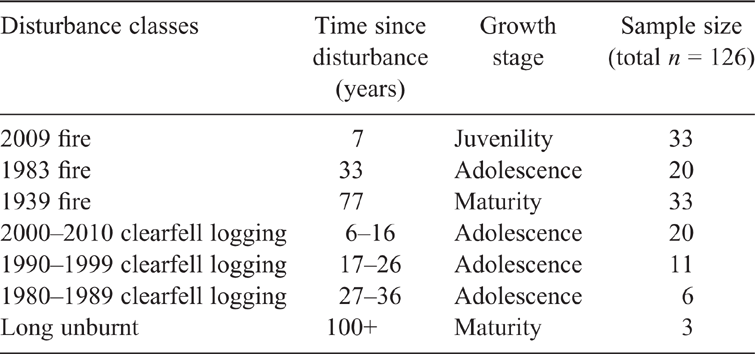
|
Field data collection
Wiregrass cover and canopy cover were assessed at each site along two 50-m transects orientated parallel and perpendicular to the slope. We used a line-point intercept method to measure cover along each transect (Elzinga et al. 1998) as the method provides higher precision than visual estimates (Godínez-Alvarez et al. 2009). Hits were recorded at 2-m intervals using a metal pin (1 m tall and 1.6 mm in diameter) oriented vertically; a hit was when the pin touches wiregrass at least once along its length. Wiregrass cover was computed as the total number of hits from the two transects divided by the total number of intervals from the two transects. Canopy cover was recorded at the same 2-m intervals along the transect using a vertical sighting tube (GRS Densitometer, Geographic Resource Solutions, Arcata, CA, USA; Wilson 2011) and using a binary system of ‘canopy’ or ‘sky’ for each point. Measurements were taken from a height of ~1.6 m, thus canopy cover as used in this study encompassed any vegetation above that height. Canopy cover was computed as the total number of ‘canopy’ hits from the two transects divided by the total number of intervals from the two transects.
Aspect and elevation were recorded at each site. Aspect was converted to degrees from north to account for the effect of topography on microclimatic conditions. North-facing slopes in the southern hemisphere have greater light intensity, higher temperatures and lower moisture availability than south-facing slopes (Swanson et al. 1988).
Environmental spatial data
We obtained precipitation and temperature variables from WorldClim 1 global coverage climate map (resolution = 0.5 min of 1°, ~1 km), which uses long-term average climate data from 1960 to 1990 (Hijmans et al. 2005). The spatial resolution of this dataset may be considered coarse for a site-level study; however, the distances between our sites are generally more than 1 km, thus it should be suitable for representing broad macroclimatic patterns. Smaller scale effects were accounted for by the elevation and aspect variables as potential indirect measures of changes in temperature and moisture at finer scales.
We used the net total solar radiation derived from Nyman et al. (2014), which accounted for the effect of topography on radiation reaching the ground. Table 2 lists all the candidate predictor variables in this study.
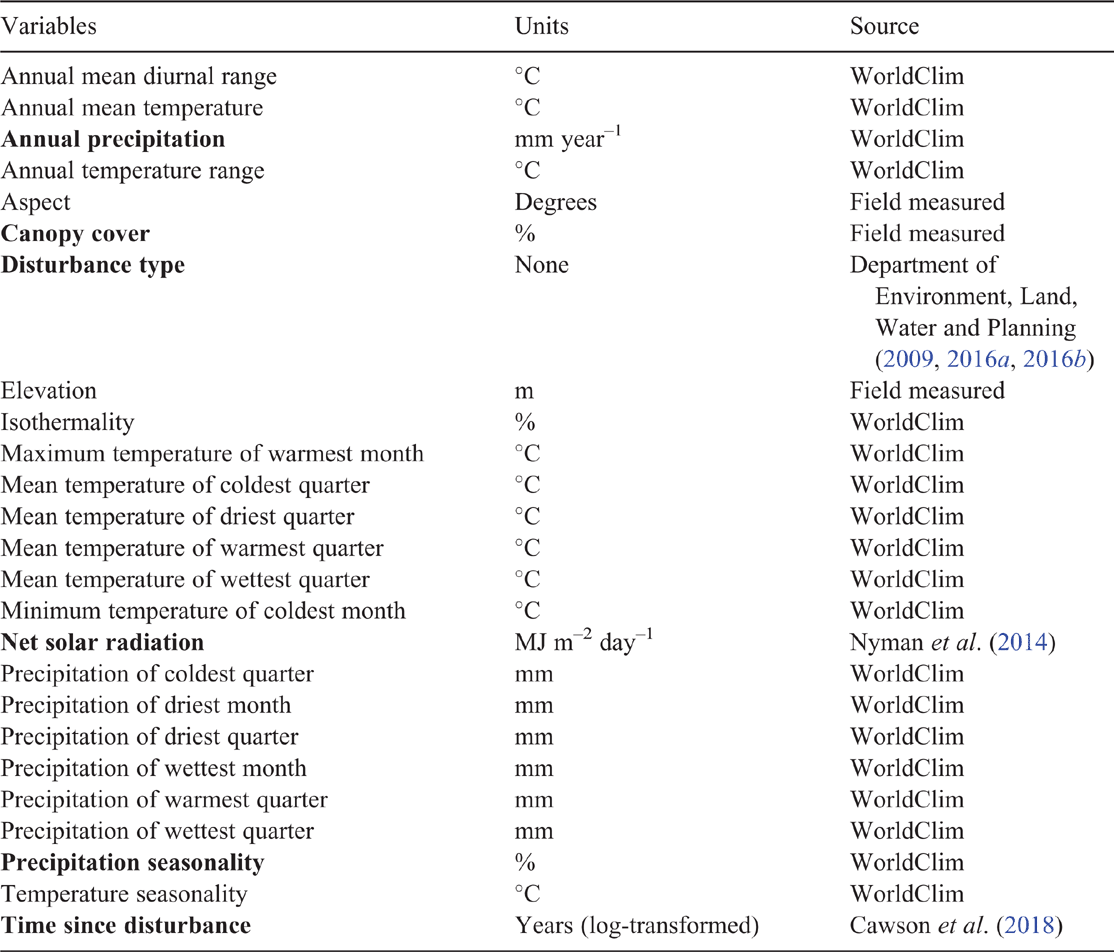
|
Data processing and analyses
A variable reduction process was undertaken to reduce the confounding effect of collinear predictor variables. Pearson correlation coefficients between predictor variables were calculated (Appendix 1). When two variables had a correlation greater than 0.7 (Green 1979; Dormann et al. 2013), we retained proximal variable over distal, or direct variable over indirect, or resource variable over non-resource. Austin (2002) defines proximal and distal as ‘the position of the predictor in the chain of processes that link the predictor to its impact on the plant’ – proximal being the more likely to be causal in determining plant responses. Direct variables are those with direct physiological effect on plants such as temperature, as opposed to indirect variables such as elevation (Austin 2002). Variables in bold in Table 2 were the final set of predictor variables after removing correlated variables.
We fitted a quasi-binomial generalised additive models (GAM) of wiregrass cover against the final set of predictor variables to determine which variables explained the observed variability of wiregrass cover. GAMs were used as they fit data-defined splines and make no assumptions about the form of the relationships before fitting. GAMs were fitted using an information theoretic approach whereby the degrees of freedom available for each model term were set using a shrinkage approach. This reduces complexity of fitted relationships where there is limited statistical support. Where statistical support for inclusion was not significant, terms were excluded from the final model (in effect, a variable selection process). A maximum of four knots were allowed for each variable in fitting the GAMs. Models were fitted in R using the mgcv package (ver. 1.8-24, https://CRAN.R-project.org/package=mgcv; Wood 2011). The Shapiro–Wilk’s test was performed on the residuals of the model to check for normality of the distribution of residuals. We checked model performance by comparing fitted values against the observed values. We determined the relative importance of predictors by calculating the change in R2 when each variable is added to the model that contains all the other variables.
All analyses were performed using R (ver. 3.5.0, R Foundation for Statistical Computing, Vienna, Austria, see at https://www.R-project.org/).
Results
Wiregrass was present in most of the study sites (115 sites out of 126), ranging in cover from 2 to 100% (mean = 43.9; s.d. = 30). Almost half (47%) of the study sites had a wiregrass cover of at least 50%, where wiregrass either formed a sward on the forest floor (Fig. 2) or climbed over rigid supports (e.g. shrubs, tree trunks, tree ferns) up to 6 m (Fig. 2). Canopy cover (i.e. the canopy provided by the vegetation from ~1.6 m and above) in the study area ranged from 46 to 96% (mean = 76.9; s.d. = 12.2), where two-thirds of the study sites had a canopy cover of more than 75%. Some sites with a canopy cover in the higher range (≥90%) still supported relatively high wiregrass cover (at most 76% cover).
The model fitting process was able to create a GAM model that explained 37.7% of the variability in wiregrass cover. The parameters of the model are presented in Table 3. The model identified six significant variables that explained the variability in cover: annual precipitation, canopy cover, disturbance type, net solar radiation, precipitation seasonality and time since disturbance. Canopy cover and net solar radiation were the top contributors of the model, with independent contributions of more than 20% of the R2 (22 and 29% respectively), whereas all the other variables contributed less than 10% each. Wiregrass cover is predicted to be high in sites with relatively low canopy cover (Fig. 3b), high net solar radiation (Fig. 3d), lower annual precipitation with less variation (Fig. 3a, c), and are recently burnt (Fig. 3c, f). The model tended to overpredict low wiregrass cover and underpredict high cover (Fig. 4).
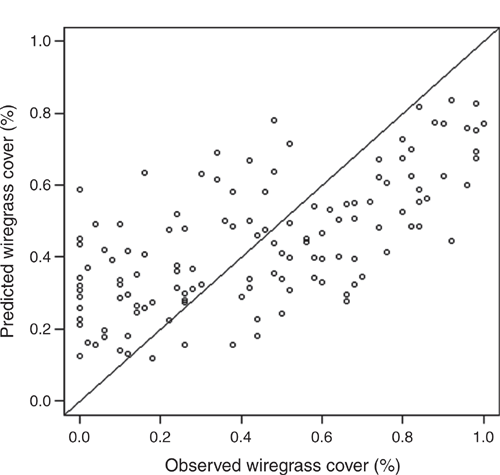
|
Discussion
Environmental factors associated with wiregrass abundance
Low canopy cover and high net solar radiation are associated with high wiregrass abundance, suggesting that wiregrass can be considered as a gap or pioneer species. Canopy cover has a direct influence on resources (i.e. solar radiation and precipitation) reaching the understorey (Valladares et al. 2016), and it is likely that for this reason it was one of the two most important factors influencing wiregrass cover. Although this may be the case, net solar radiation reaching wiregrass in the understorey can differ between sites having the same canopy cover but different aspect (equator-facing v. pole-facing slope) (Swanson et al. 1988), hence the independent effect of net solar radiation from canopy cover on wiregrass cover. The variability of wiregrass cover in the understorey is likely to be a net response to a combination of factors shaped by the canopy cover. Stands with sparse canopies let more light and precipitation into the understorey than stands with dense canopies (Anderson et al. 1969; Chen et al. 1999), but the moisture will be reduced because of increased evaporation (Nyman et al. 2018). These conditions under sparser canopies correspond to higher wiregrass cover. This pattern is consistent with the results of Ashwell (1985), who found wiregrass was highly abundant in illuminated, drier areas. Further research is needed to decouple the effects of light and water (both influenced by canopy cover) on wiregrass growth and biomass to help us understand the individual role and interactive effects of these resources on wiregrass dominance.
Disturbance in general was associated with high wiregrass cover, suggesting that wiregrass can take advantage of disturbances to become dominant. Wapstra et al. (2003) observed that wiregrass occurrence in Tasmania was more pronounced in greatly disturbed sites (disturbances include fire, logging and anthropogenic ones). Disturbance has been associated with native species becoming unusually dominant in their own range (Pivello et al. 2018), and also with exotic invasive species that dominate new areas (Sher and Hyatt 1999).
The influence of time since disturbance on wiregrass cover in the understorey is likely mediated by direct effects on competition and indirect effect by changes in canopy cover. During early post-disturbance, competition among species for space and resources is lesser as many species are eliminated (Sousa 1984), which means that species with the ability to reproduce asexually like wiregrass can quickly increase in abundance (Ashton and Martin 1996). Furthermore, resources (e.g. light) can increase where disturbances reduce the canopy cover. Consequently, wiregrass cover can become relatively higher in the recently disturbed sites. Wiregrass cover did not continue to decline significantly as time since disturbance increased, most likely because of declining number of stems per hectare in mountain ash forest as it ages (Ashton 1976). This decline in the number of stems per hectare allows gradual increase in light to the understorey. Wiregrass cover is likely to increase again in very old stands (~200 years) where light may have significantly increased (Ashton 1976).
Fire and logging disturbances differed in their effects on wiregrass cover, most probably because of the differential degree of disturbance fire and logging had on the sites. Logging disturbs both vegetation and soil (Murphy and Ough 1997; Lindenmayer and Ough 2006), whereas fire mainly disturbs the vegetation. Soil disturbance during a logging operation may expose soil-stored seeds and rhizomes, which are then destroyed during the burning employed as part of the clear-fell logging procedure (Lindenmayer and Ough 2006). Consequently, wiregrass regeneration after clear-fell logging is potentially lower than after fire. Fire does not necessarily disturb the soil, and the smoke stimulates wiregrass seeds to germinate (Penman et al. 2008). This could explain relatively higher wiregrass cover in burnt than logged sites.
Our results suggest that climatic factors affect wiregrass abundance. Wiregrass cover was significantly correlated with both annual precipitation and precipitation seasonality, even though the data resolution was coarse. However, the precipitation variables were highly correlated with temperature variables, so it is unclear whether precipitation or temperature is more important to wiregrass cover. Whichever is the case, it is clear that climate variables can be important determinants of wiregrass abundance.
An important biotic factor that may contribute to the remaining unexplained variance (>50%) in wiregrass cover is herbivory, which we did not include in our study. Herbivores like the wombat (Vombatus ursinus Shaw, 1800) (Ashwell 1985; Ashton and Chappill 1989), sambar deer (Cervus unicolor Kerr, 1972) (Forsyth and Davis 2011), eastern grey kangaroo (Macropus giganteus Shaw, 1790) and black wallaby (Wallabia bicolor Desmarest, 1804) (de Munk 1999) reportedly graze on wiregrass. It has been suggested that wombat abundance could have a considerable effect on wiregrass cover (Ashwell 1985; Ashton and Chappill 1989). Further research could consider the influence of herbivory on wiregrass abundance and structure.
Role of wiregrass in a positive fire–flammability feedback
Our results suggest that wiregrass has the potential to create a positive fire–flammability feedback in mountain ash forests, akin to the grass–fire cycle in other systems. The grass–fire cycle is based on several premises (D’Antonio and Vitousek 1992; Rossiter et al. 2003). First, that grass dominance alters fuel characteristics leading to increased fire frequency, extent or intensity. Field studies by Buckley (1993) suggest that this is the case with wiregrass. When wiregrass is abundant, fires are more likely to ignite and spread at high surface fuel moisture contents, i.e. greater than 20% (Buckley 1993) when fires would otherwise self-extinguish (Cheney 1981). Another premise underpinning the grass–fire cycle is that altered fire regimes resulting from the abundance of particular grasses can create changes in tree cover. Altered fire regimes (i.e. increased fire frequency) in mountain ash forests can eliminate mountain ash from a site (Fairman et al. 2016). The extent that wiregrass abundance drives fire frequency in these forests is unclear. The final premise of the grass–fire cycle is that grass cover increases in the post-fire community. Our results show that wiregrass cover is higher in recently burnt sites than long-unburnt ones, with fire disturbance likely acting as a stimulus for wiregrass growth. This evidence suggests that the grass–fire cycle may be applicable to wiregrass in mountain ash forests, but further research is needed to determine the importance of wiregrass abundance to fire frequency or extent in these forests.
Potential effect of climate change on wiregrass abundance
Fire frequency is hypothesised to increase under future climate change scenarios (Pitman et al. 2007; Bradstock et al. 2014; Seidl et al. 2017), and precipitation is predicted to decrease in south-eastern Australia (Whetton 2011). Both these conditions could increase the abundance of wiregrass, although that would also depend on the lower limit of moisture tolerance of wiregrass. Increased aridity may also reduce wiregrass abundance if moisture becomes a factor limiting wiregrass growth. Further study is needed to determine how wiregrass responds to drought, and how reduced canopy cover caused by disturbance interacts with effects of low moisture on wiregrass.
Conclusion
Dominant species can strongly influence the flammability of vegetation communities, hence understanding the factors affecting the abundance of such species are important. Wiregrass, a species that increases the flammability of forest understoreys when it occurs abundantly, was found to increase in abundance in recently disturbed sites with reduced canopy cover, more light and lower precipitation. This suggests that disturbances such as fire that reduce canopy cover in sites where wiregrass is present can promote wiregrass dominance, which in turn increases flammability. This may create a positive flammability feedback.
Conflicts of interest
The authors declare that they have no conflicts of interest.
Declaration of funding
Funding was received through a Melbourne International Research Scholarship and the research project ‘Managing bushfire in tall mist forests – fuel hazard and moisture relationships’. This project was managed within the Integrated Forest Ecosystem Research program, a research program conducted by the University of Melbourne and funded by the Victorian Government’s Department of Environment, Land, Water and Planning (DELWP).
Acknowledgments
This research was conducted as part of a PhD project. We thank Simon Murphy, April Gloury, Tom Fairman, Naomi Davis and Peter Mercouriou for their assistance with field data collection, and Matthew Swan for his help in site selection. We also thank the two anonymous reviewers and Handling Editor Dr James Camac for their valuable comments on the manuscript.
References
Anderson RC, Loucks OL, Swain AM (1969) Herbaceous response to canopy cover, light intensity, and throughfall precipitation in coniferous forests. Ecology 50, 255–263.| Herbaceous response to canopy cover, light intensity, and throughfall precipitation in coniferous forests.Crossref | GoogleScholarGoogle Scholar |
Ashton DH (1976) The development of even-aged stands of Eucalyptus regnans F.Muell. in central Victoria. Australian Journal of Botany 24, 397–414.
| The development of even-aged stands of Eucalyptus regnans F.Muell. in central Victoria.Crossref | GoogleScholarGoogle Scholar |
Ashton DH (1981) Fire in tall open-forests (wet sclerophyll forests). In ‘Fire and the Australian Biota’. (Eds AM Gill, RH Groves, IR Noble) pp. 340–366. (Australian Academy of Science: Canberra, ACT, Australia)
Ashton DH, Attiwill PM (1994) Tall open forests. In ‘Australian Vegetation’. (Ed. RH Groves) pp. 157–196. (Cambridge University Press: Cambridge, UK)
Ashton DH, Chappill JA (1989) Secondary succession in post-fire scrub dominated by Acacia verticillata (L’herit) Willd. at Wilsons Promontory, Victoria. Australian Journal of Botany 37, 1–18.
| Secondary succession in post-fire scrub dominated by Acacia verticillata (L’herit) Willd. at Wilsons Promontory, Victoria.Crossref | GoogleScholarGoogle Scholar |
Ashton DH, Martin D (1996) Regeneration in a pole-stage forest of Eucalyptus regnans subjected to different fire intensities in 1982. Australian Journal of Botany 44, 393–410.
| Regeneration in a pole-stage forest of Eucalyptus regnans subjected to different fire intensities in 1982.Crossref | GoogleScholarGoogle Scholar |
Ashwell D (1985) The importance of Tetrarrhena juncea in the ecology of Eucalyptus regnans stands. M.Sc. thesis, Faculty of Science, The University of Melbourne, Parkville, Vic., Australia.
Austin MP (2002) Spatial prediction of species distribution: an interface between ecological theory and statistical modelling. Ecological Modelling 157, 101–118.
| Spatial prediction of species distribution: an interface between ecological theory and statistical modelling.Crossref | GoogleScholarGoogle Scholar |
Badano EI, Cavieres LA, Molina-Montenegro MA, Quiroz CL (2005) Slope aspect influences plant association patterns in the Mediterranean matorral of central Chile. Journal of Arid Environments 62, 93–108.
| Slope aspect influences plant association patterns in the Mediterranean matorral of central Chile.Crossref | GoogleScholarGoogle Scholar |
Benyon RG, Lane PNJ (2013) Ground and satellite-based assessments of wet eucalypt forest survival and regeneration for predicting long-term hydrological responses to a large wildfire. Forest Ecology and Management 294, 197–207.
| Ground and satellite-based assessments of wet eucalypt forest survival and regeneration for predicting long-term hydrological responses to a large wildfire.Crossref | GoogleScholarGoogle Scholar |
Berry ZC, Wevill K, Curran TJ (2011) The invasive weed Lantana camara increases fire risk in dry rainforest by altering fuel beds. Weed Research 51, 525–533.
| The invasive weed Lantana camara increases fire risk in dry rainforest by altering fuel beds.Crossref | GoogleScholarGoogle Scholar |
Bradstock R, Penman T, Boer M, Price O, Clarke H (2014) Divergent responses of fire to recent warming and drying across south-eastern Australia. Global Change Biology 20, 1412–1428.
| Divergent responses of fire to recent warming and drying across south-eastern Australia.Crossref | GoogleScholarGoogle Scholar | 24151212PubMed |
Brooks ML, D’Antonio CM, Richardson DM, Grace JB, Keeley JE, Ditomaso JM, Hobbs RJ, Pellant M, Pyke D (2004) Effects of invasive alien plants on fire regimes. Bioscience 54, 677–688.
| Effects of invasive alien plants on fire regimes.Crossref | GoogleScholarGoogle Scholar |
Buckley AJ (1993) Fuel reducing regrowth forests with a wiregrass fuel type: fire behaviour guide and prescriptions. Research report number 40. Fire Management Branch, Department of Conservation and Natural Resources, Melbourne, Vic., Australia.
Cawson JG, Duff TJ, Swan MH, Penman TD (2018) Wildfire in wet sclerophyll forests: the interplay between disturbances and fuel dynamics. Ecosphere 9, e02211
| Wildfire in wet sclerophyll forests: the interplay between disturbances and fuel dynamics.Crossref | GoogleScholarGoogle Scholar |
Chávez V, Macdonald SE (2010) The influence of canopy patch mosaics on understory plant community composition in boreal mixedwood forest. Forest Ecology and Management 259, 1067–1075.
| The influence of canopy patch mosaics on understory plant community composition in boreal mixedwood forest.Crossref | GoogleScholarGoogle Scholar |
Cheal D (2010) Growth stages and tolerable fire intervals for Victoria’s native vegetation data sets. Fire and adaptive management. Report number 84. Victorian Government Department of Sustainability and Environment, Melbourne, Vic., Australia.
Chen J, Franklin JF, Spies TA (1995) Growing-season microclimatic gradients from clearcut edges into old-growth Douglas-fir forests. Ecological Applications 5, 74–86.
| Growing-season microclimatic gradients from clearcut edges into old-growth Douglas-fir forests.Crossref | GoogleScholarGoogle Scholar |
Chen J, Mroz GD, Franklin JF, Brosofske KD, Saunders SC, Crow TR, Naiman RJ, Brookshire BL (1999) Microclimate in forest ecosystem and landscape ecology: variations in local climate can be used to monitor and compare the effects of different management regimes. Bioscience 49, 288–297.
| Microclimate in forest ecosystem and landscape ecology: variations in local climate can be used to monitor and compare the effects of different management regimes.Crossref | GoogleScholarGoogle Scholar |
Cheney NP (1981) Fire behaviour. ‘Fire and the Australian Biota’. (Eds AM Gill, RH Groves, IR Noble) pp. 151–175. (Australian Academy of Science: Canberra, ACT, Australia)
Collins P (2009) ‘Burn’: the Epic Story of Bushfire in Australia’: with an Introduction on the Black Saturday Fires.’ (Scribe Publications: Melbourne, Vic., Australia)
D’Antonio CM, Vitousek PM (1992) Biological invasions by exotic grasses, the grass/fire cycle, and global change. Annual Review of Ecology and Systematics 23, 63–87.
| Biological invasions by exotic grasses, the grass/fire cycle, and global change.Crossref | GoogleScholarGoogle Scholar |
D’Antonio CM, Odion DC, Tyler CM (1993) Invasion of maritime chaparral by the introduced succulent Carpobrotus edulis: the roles of fire and herbivory. Oecologia 95, 14–21.
| Invasion of maritime chaparral by the introduced succulent Carpobrotus edulis: the roles of fire and herbivory.Crossref | GoogleScholarGoogle Scholar | 28313306PubMed |
de Munk FG (1999) Resource use by the eastern grey kangaroo and the black wallaby in a managed remnant woodland community. PhD thesis, School of Ecology and Environment, Deakin University, Melbourne, Vic., Australia.
Department of Environment, Land, Water and Planning (2009) Victorian bushfires severity map 2009 (polygons). (Victorian Government Department of Environment, Land, Water and Planning: Melbourne, Vic., Australia) Available at https://discover.data.vic.gov.au/dataset/victorian-bushfires-severity-map-2009-polygons [Verified 31 March 2020]
Department of Environment, Land, Water and Planning (2016a) Fire history records of fires primarily on public land. (Victorian Government Department of Environment, Land, Water and Planning: Melbourne, Vic., Australia) Available at https://discover.data.vic.gov.au/dataset/fire-history-records-of-fires-primarily-on-public-land [Verified 31 March 2020]
Department of Environment, Land, Water and Planning (2016b) Modelled old-growth boundaries. (Victorian Government Department of Environment, Land, Water and Planning: Melbourne, Vic., Australia) Available at https://discover.data.vic.gov.au/dataset/modelled-old-growth-forest-boundaries [Verified 31 March 2020]
Department of Environment, Land, Water and Planning (2016c) Logging history overlay of most recent harvesting activities. (Victorian Government Department of Environment, Land, Water and Planning: Melbourne, Vic., Australia) Available at https://discover.data.vic.gov.au/dataset/logging-history-overlay-of-most-recent-harvesting-activities [Verified 31 March 2020]
Department of Sustainability and Environment (2004) Highlands southern fall bioregion. ECV/Bioregion benchmark for vegetation quality assessment. (Victorian Government Department of Sustainability and Environment: Vic., Australia) Available at https://www.environment.vic.gov.au/biodiversity/bioregions-and-evc-benchmarks [Verified 31 March 2020]
Dormann CF, Elith J, Bacher S, Buchmann C, Carl G, Carré G, Marquéz JRG, Gruber B, Lafourcade B, Leitão PJ, Münkemüller T, McClean C, Osborne PE, Reineking B, Schröder B, Skidmore AK, Zurell D, Lautenbach S (2013) Collinearity: a review of methods to deal with it and a simulation study evaluating their performance. Ecography 36, 27–46.
| Collinearity: a review of methods to deal with it and a simulation study evaluating their performance.Crossref | GoogleScholarGoogle Scholar |
Duff T, Keane R, Penman T, Tolhurst K (2017) Revisiting wildland fire fuel quantification methods: the challenge of understanding a dynamic, biotic entity. Forests 8, 351
| Revisiting wildland fire fuel quantification methods: the challenge of understanding a dynamic, biotic entity.Crossref | GoogleScholarGoogle Scholar |
Elzinga CL, Salzer DW, Willoughby JW) (1998) ‘Measuring and Monitoring Plant Populations.’ (US Department of the Interior, Bureau of Land Management, National Applied Resource Sciences Centre: Denver, CO, USA)
Fairman TA, Nitschke CR, Bennett LT (2016) Too much, too soon? A review of the effects of increasing wildfire frequency on tree mortality and regeneration in temperate eucalypt forests. International Journal of Wildland Fire 25, 831–848.
| Too much, too soon? A review of the effects of increasing wildfire frequency on tree mortality and regeneration in temperate eucalypt forests.Crossref | GoogleScholarGoogle Scholar |
Florence RG (1996) ‘Ecology and Silviculture of Eucalypt Forests.’ (CSIRO Publishing: Melbourne, Vic., Australia)
Fogarty LG (1993) ‘The Accumulation and Structural Development of the Wiregrass (Tetrarrhena juncea) fuel type in East Gippsland.’ (Fire Management Branch, Department of Conservation and Natural Resources: Melbourne, Vic., Australia)
Forsyth DM, Davis NE (2011) Diets of non-native deer in Australia estimated by macroscopic versus microhistological rumen analysis. Journal of Wildlife Management 75, 1488–1497.
| Diets of non-native deer in Australia estimated by macroscopic versus microhistological rumen analysis.Crossref | GoogleScholarGoogle Scholar |
Fraser IP, Williams RJ, Murphy BP, Camac JS, Vesk PA (2016) Fuels and landscape flammability in an Australian alpine environment. Austral Ecology 41, 657–670.
| Fuels and landscape flammability in an Australian alpine environment.Crossref | GoogleScholarGoogle Scholar |
Gaff D, Latz P (1978) The occurrence of resurrection plants in the Australian flora. Australian Journal of Botany 26, 485–492.
| The occurrence of resurrection plants in the Australian flora.Crossref | GoogleScholarGoogle Scholar |
Gill AM (1981) Adaptive responses of Australian vascular plant species to fires. ‘Fire and the Australian Biota’. (Eds AM Gill, RH Groves, IR Noble) pp. 243–272. (Australian Academy of Science: Canberra, ACT, Australia)
Gill AM, Zylstra P (2005) Flammability of Australian forests. Australian Forestry 68, 87–93.
| Flammability of Australian forests.Crossref | GoogleScholarGoogle Scholar |
Godínez-Alvarez H, Herrick JE, Mattocks M, Toledo D, Van Zee J (2009) Comparison of three vegetation monitoring methods: their relative utility for ecological assessment and monitoring. Ecological Indicators 9, 1001–1008.
| Comparison of three vegetation monitoring methods: their relative utility for ecological assessment and monitoring.Crossref | GoogleScholarGoogle Scholar |
Green RH (1979) ‘Sampling Design and Statistical Methods for Environmental Biologists.’ (Wiley: New York, NY, USA)
Griffiths T (2001) ‘Forests of Ash’: an Environmental History.’ (Cambridge University Press: Cambridge, UK)
Hijmans RJ, Cameron SE, Parra JL, Jones PG, Jarvis A (2005) Very high resolution interpolated climate surfaces for global land areas. International Journal of Climatology 25, 1965–1978.
| Very high resolution interpolated climate surfaces for global land areas.Crossref | GoogleScholarGoogle Scholar |
Holmgren M, Scheffer M, Huston MA (1997) The interplay of facilitation and competition in plant communities. Ecology 78, 1966–1975.
| The interplay of facilitation and competition in plant communities.Crossref | GoogleScholarGoogle Scholar |
Jacobs A, Vanboxel J, Elkilani R (1994) Nighttime free-convection characteristics within a plant canopy. Boundary-Layer Meteorology 71, 375–391.
| Nighttime free-convection characteristics within a plant canopy.Crossref | GoogleScholarGoogle Scholar |
Kullman L (2008) Thermophilic tree species reinvade subalpine Sweden – early responses to anomalous late Holocene climate warming. Arctic, Antarctic, and Alpine Research 40, 104–110.
| Thermophilic tree species reinvade subalpine Sweden – early responses to anomalous late Holocene climate warming.Crossref | GoogleScholarGoogle Scholar |
Lamp C, Cade JW, Forbes SJ, Barnett AG, Morris D, Tucker J (2001) ‘Grasses of Temperate Australia: a Field Guide.’ (CH Jerram: Melbourne, Vic., Australia)
Lindenmayer DB, Ough K (2006) Salvage logging in the montane ash eucalypt forests of the Central Highlands of Victoria and its potential impacts on biodiversity. Conservation Biology 20, 1005–1015.
| Salvage logging in the montane ash eucalypt forests of the Central Highlands of Victoria and its potential impacts on biodiversity.Crossref | GoogleScholarGoogle Scholar | 16922217PubMed |
Lindenmayer DB, Cunningham RB, Donnelly CF, Franklin JF (2000) Structural features of old-growth Australian montane ash forests. Forest Ecology and Management 134, 189–204.
| Structural features of old-growth Australian montane ash forests.Crossref | GoogleScholarGoogle Scholar |
McCarthy MA, Lindenmayer DB (1998) Multi-aged mountain ash forest, wildlife conservation and timber harvesting. Forest Ecology and Management 104, 43–56.
| Multi-aged mountain ash forest, wildlife conservation and timber harvesting.Crossref | GoogleScholarGoogle Scholar |
Murphy A, Ough K (1997) Regenerative strategies of understorey flora following clearfell logging in the Central Highlands, Victoria. Australian Forestry 60, 90–98.
| Regenerative strategies of understorey flora following clearfell logging in the Central Highlands, Victoria.Crossref | GoogleScholarGoogle Scholar |
Murphy BP, Bradstock RA, Boer MM, Carter J, Cary GJ, Cochrane MA, Fensham RJ, Russell-Smith J, Williamson GJ, Bowman DMJS (2013) Fire regimes of Australia: a pyrogeographic model system. Journal of Biogeography 40, 1048–1058.
| Fire regimes of Australia: a pyrogeographic model system.Crossref | GoogleScholarGoogle Scholar |
Niinemets U, Valladares F (2004) Photosynthetic acclimation to simultaneous and interacting environmental stresses along natural light gradients: optimality and constraints. Plant Biology 6, 254–268.
| Photosynthetic acclimation to simultaneous and interacting environmental stresses along natural light gradients: optimality and constraints.Crossref | GoogleScholarGoogle Scholar | 15143434PubMed |
Nyman P, Sherwin CB, Langhans C, Lane PNJ, Sheridan GJ (2014) Downscaling regional climate data to calculate the radiative index of dryness in complex terrain. Australian Meteorological and Oceanographic Journal 64, 109–122.
| Downscaling regional climate data to calculate the radiative index of dryness in complex terrain.Crossref | GoogleScholarGoogle Scholar |
Nyman P, Baillie CC, Duff TJ, Sheridan GJ (2018) Eco-hydrological controls on microclimate and surface fuel evaporation in complex terrain. Agricultural and Forest Meteorology 252, 49–61.
| Eco-hydrological controls on microclimate and surface fuel evaporation in complex terrain.Crossref | GoogleScholarGoogle Scholar |
Ough K, Ross J (1992) ‘Floristics, Fire and Clearfelling in Wet Forests of the Central Highlands, Victoria.’ (Flora Branch, Flora and Fauna Division, Department of Conservation and Environment: Melbourne, Vic., Australia)
Parker IM, Simberloff D, Lonsdale WM, Goodell K, Wonham M, Kareiva PM, Williamson MH, Holle BV, Moyle PB, Byers JE, Goldwasser L (1999) Impact: toward a framework for understanding the ecological effects of invaders. Biological Invasions 1, 3–19.
| Impact: toward a framework for understanding the ecological effects of invaders.Crossref | GoogleScholarGoogle Scholar |
Penman T, Binns DL, Shiels RJ, Allen RM, Plummer SH (2008) Germination responses of a dry sclerophyll forest soil stored seed bank to fire related cues. Cunninghamia 10, 547–555.
Penman TD, Binns DL, Brassil TE, Shiels RJ, Allen RM (2009) Long-term changes in understorey vegetation in the absence of wildfire in south-east dry sclerophyll forests. Australian Journal of Botany 57, 533–540.
| Long-term changes in understorey vegetation in the absence of wildfire in south-east dry sclerophyll forests.Crossref | GoogleScholarGoogle Scholar |
Pitman AJ, Narisma GT, McAneney J (2007) The impact of climate change on the risk of forest and grassland fires in Australia. Climatic Change 84, 383–401.
| The impact of climate change on the risk of forest and grassland fires in Australia.Crossref | GoogleScholarGoogle Scholar |
Pivello VR, Vieira MV, Grombone-Guaratini MT, Matos DMS (2018) Thinking about super-dominant populations of native species – examples from Brazil. Perspectives in Ecology and Conservation 16, 74–82.
| Thinking about super-dominant populations of native species – examples from Brazil.Crossref | GoogleScholarGoogle Scholar |
Rossiter NA, Setterfield SA, Douglas MM, Hutley LB (2003) Testing the grass–fire cycle: alien grass invasion in the tropical savannas of northern Australia. Diversity & Distributions 9, 169–176.
| Testing the grass–fire cycle: alien grass invasion in the tropical savannas of northern Australia.Crossref | GoogleScholarGoogle Scholar |
Scarff FR, Westoby M (2006) Leaf litter flammability in some semi-arid Australian woodlands. Functional Ecology 20, 745–752.
| Leaf litter flammability in some semi-arid Australian woodlands.Crossref | GoogleScholarGoogle Scholar |
Schwilk DW (2003) Flammability is a niche construction trait: canopy architecture affects fire intensity. American Naturalist 162, 725–733.
| Flammability is a niche construction trait: canopy architecture affects fire intensity.Crossref | GoogleScholarGoogle Scholar | 14737710PubMed |
Schwilk DW (2015) Dimensions of plant flammability. New Phytologist 206, 486–488.
| Dimensions of plant flammability.Crossref | GoogleScholarGoogle Scholar | 25800615PubMed |
Schwilk DW, Caprio AC (2011) Scaling from leaf traits to fire behaviour: community composition predicts fire severity in a temperate forest. Journal of Ecology 99, 970–980.
| Scaling from leaf traits to fire behaviour: community composition predicts fire severity in a temperate forest.Crossref | GoogleScholarGoogle Scholar |
Seidl R, Thom D, Kautz M, Martin-Benito D, Peltoniemi M, Vacchiano G, Wild J, Ascoli D, Petr M, Honkaniemi J, Lexer MJ, Trotsiuk V, Mairota P, Svoboda M, Fabrika M, Nagel TA, Reyer CPO (2017) Forest disturbances under climate change. Nature Climate Change 7, 395–402.
| Forest disturbances under climate change.Crossref | GoogleScholarGoogle Scholar | 28861124PubMed |
Setterfield SA, Rossiter-Rachor NA, Hutley LB, Douglas MM, Williams RJ (2010) Turning up the heat: the impacts of Andropogon gayanus (gamba grass) invasion on fire behaviour in northern Australian savannas. Diversity & Distributions 16, 854–861.
| Turning up the heat: the impacts of Andropogon gayanus (gamba grass) invasion on fire behaviour in northern Australian savannas.Crossref | GoogleScholarGoogle Scholar |
Sher AA, Hyatt LA (1999) The disturbed resource-flux invasion matrix: a new framework for patterns of plant invasion. Biological Invasions 1, 107–114.
| The disturbed resource-flux invasion matrix: a new framework for patterns of plant invasion.Crossref | GoogleScholarGoogle Scholar |
Sousa WP (1984) The role of disturbance in natural communities. Annual Review of Ecology and Systematics 15, 353–391.
| The role of disturbance in natural communities.Crossref | GoogleScholarGoogle Scholar |
Stuwe J, Mueck SG (1990) ‘Vegetation and Classification of the Cabbage Tree Creek Study Area.’ (Department of Conservation, Forests and Lands: Melbourne, Vic., Australia)
Swanson FJ, Kratz TK, Caine N, Woodmansee RG (1988) Landform effects on ecosystem patterns and processes. Bioscience 38, 92–98.
| Landform effects on ecosystem patterns and processes.Crossref | GoogleScholarGoogle Scholar |
Tumino BJ, Duff TJ, Goodger JQD, Cawson JG (2019) Plant traits linked to field-scale flammability metrics in prescribed burns in Eucalyptus forest. PLoS One 14, e0221403
| Plant traits linked to field-scale flammability metrics in prescribed burns in Eucalyptus forest.Crossref | GoogleScholarGoogle Scholar | 31449564PubMed | [Corrigendum appears in PLoS ONE 2019, 14(9), e0223401. https://doi.org/10.1371/journal.pone.0223401]
Valladares F, Laanisto L, Niinemets Ü, Zavala MA (2016) Shedding light on shade: ecological perspectives of understorey plant life. Plant Ecology & Diversity 9, 237–251.
| Shedding light on shade: ecological perspectives of understorey plant life.Crossref | GoogleScholarGoogle Scholar |
van Wilgen BW, Richardson DM (1985) The effects of alien shrub invasions on vegetation structure and fire behaviour in South African fynbos shrublands: a simulation study. Journal of Applied Ecology 22, 955–966.
| The effects of alien shrub invasions on vegetation structure and fire behaviour in South African fynbos shrublands: a simulation study.Crossref | GoogleScholarGoogle Scholar |
Vesperinas ES, Moreno AG, Elorza MS, Sánchez ED, Mata DS, Gavilán R (2001) The expansion of thermophilic plants in the Iberian Peninsula as a sign of climatic change. ‘Fingerprints of Climate Change’. (Eds GR Walther, CA Burga, PJ Edwards) pp. 163–184. (Springer: Boston, MA, USA)
Walsh NG, Entwisle TJ (1994) ‘Flora of Victoria.’ (Inkata Press: Melbourne, Vic., Australia)
Wapstra M, French B, Ashlin T (2003) Distribution, habitat characteristics and conservation status of the forest wire-grass Ehrharta juncea (R.Br.) Sprengel (Poaceae) in Tasmania. Tasforests 14, 77–92.
Whetton P (2011) Future Australian climate scenarios. In ‘Climate Change: Science and Solutions for Australia’. (Eds H Cleugh, MS Smith, M Battaglia, P Graham) pp. 34–43. (CSIRO Publishing: Melbourne, Vic., Australia)
Willis JH (1970) ‘A Handbook to Plants in Victoria, Vol. 1. Ferns, Conifers and Monocotyledons.’ (Melbourne University Press: Melbourne, Vic., Australia)
Wilson JB (2011) Cover plus: ways of measuring plant canopies and the terms used for them. Journal of Vegetation Science 22, 197–206.
| Cover plus: ways of measuring plant canopies and the terms used for them.Crossref | GoogleScholarGoogle Scholar |
Wood SN (2011) Fast stable restricted maximum likelihood and marginal likelihood estimation of semiparametric generalized linear models. Journal of the Royal Statistical Society. Series B, Statistical Methodology 73, 3–36.
| Fast stable restricted maximum likelihood and marginal likelihood estimation of semiparametric generalized linear models.Crossref | GoogleScholarGoogle Scholar |
Zedler PH, Scheid GA (1988) Invasion of Carpobrotus edulis and Salix lasiolepis after fire in a coastal chaparral site in Santa Barbara County, California. Madrono 35, 196–201.
Zylstra P (2011) Modelling and managing a complex system. PhD thesis, School of Physical, Environmental and Mathematical Sciences, The University of New South Wales, Sydney, NSW, Australia.
Zylstra P, Bradstock RA, Bedward M, Penman TD, Doherty MD, Weber RO, Gill AM, Cary GJ (2016) Biophysical mechanistic modelling quantifies the effects of plant traits on fire severity: species, not surface fuel loads, determine flame dimensions in eucalypt forests. PLoS One 11, e0160715
| Biophysical mechanistic modelling quantifies the effects of plant traits on fire severity: species, not surface fuel loads, determine flame dimensions in eucalypt forests.Crossref | GoogleScholarGoogle Scholar | 27529789PubMed |
Appendix 1. Pairwise correlations of continuous predictor variables
Correlation values ≥0.70 are in bold
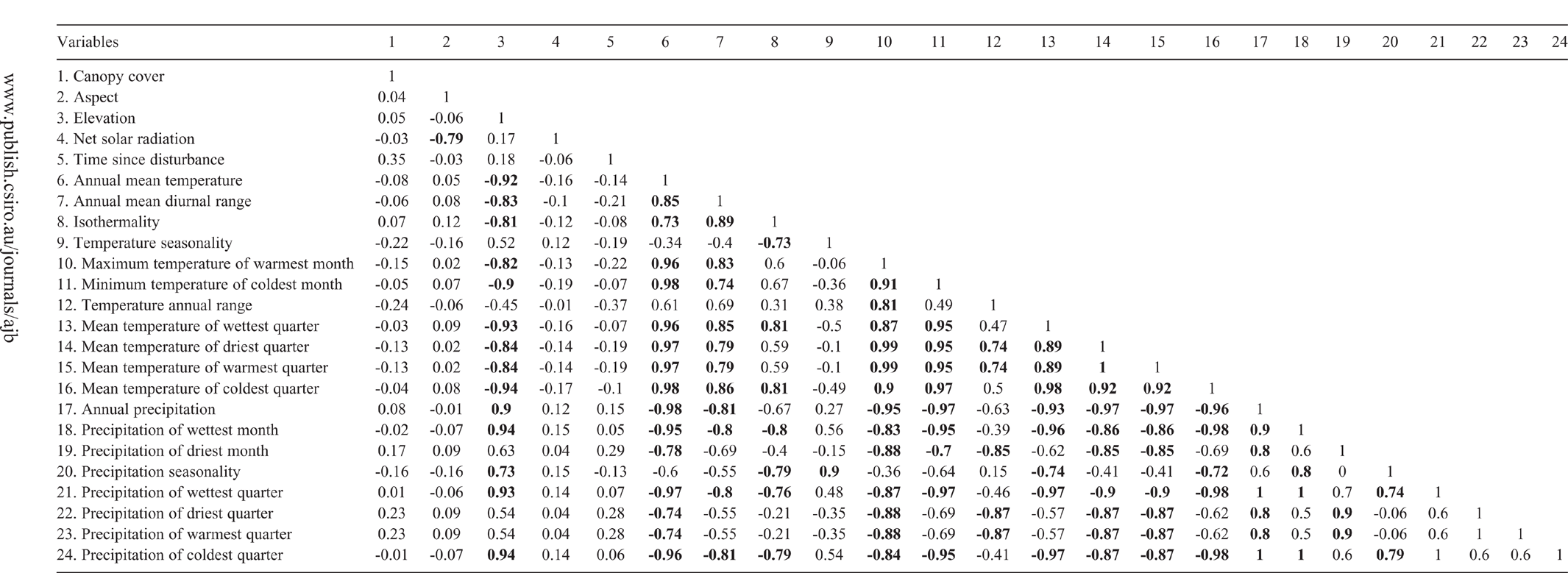
|


